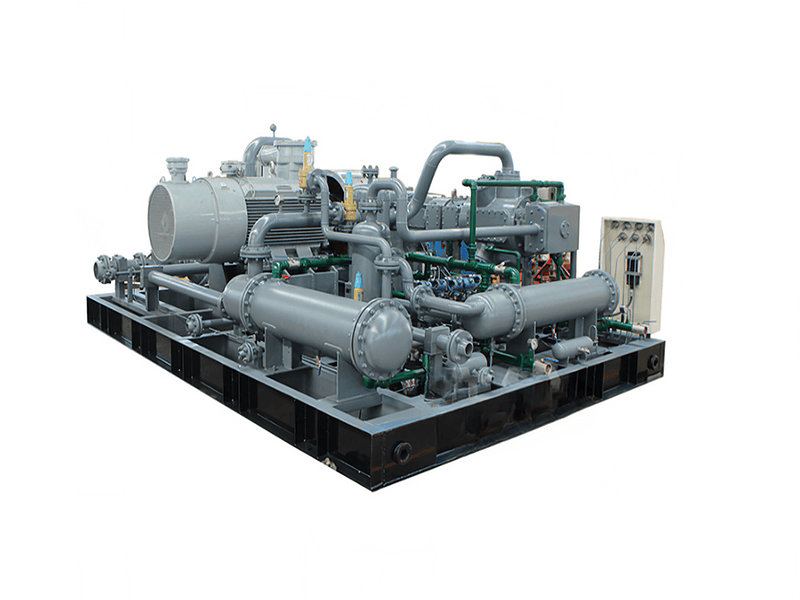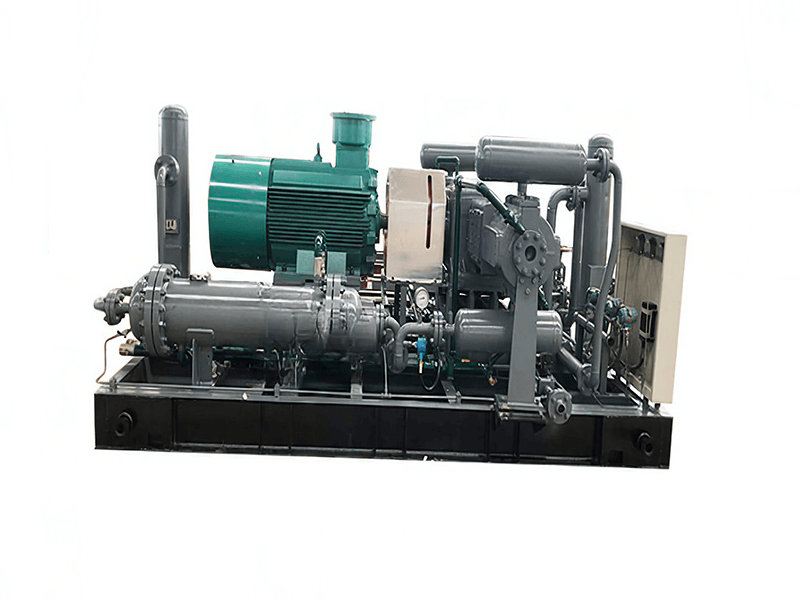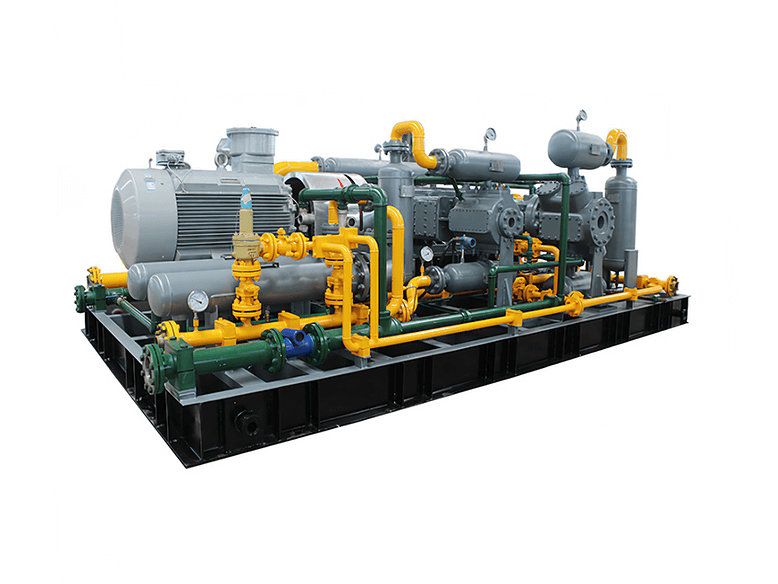Mixed gas compressors are specialized compressors designed to handle gases with varying compositions or mixtures. They are commonly used in industries such as oil and gas, petrochemicals, chemical processing, and gas production. Here are some types of mixed gas compressors:
1. Reciprocating Compressors: Reciprocating compressors use a piston-cylinder arrangement to compress gases. They are suitable for handling mixed gases with varying compositions. These compressors can be configured as single-stage or multi-stage, depending on the pressure requirements. Reciprocating compressors are known for their high efficiency and ability to handle a wide range of gas mixtures.
2. Screw Compressors: Screw compressors use interlocking helical rotors to compress gases. They are well-suited for handling mixed gases with different compositions and operating conditions. Screw compressors offer continuous and pulsation-free operation, making them suitable for applications requiring a steady flow of mixed gases.
3. Centrifugal Compressors: Centrifugal compressors utilize a high-speed impeller to impart kinetic energy to the gas, which is then converted into pressure. They are commonly used for handling large volumes of mixed gases in industrial applications. Centrifugal compressors are preferred for applications where a high flow rate and low compression ratio are required.
4. Diaphragm Compressors: Diaphragm compressors use a flexible diaphragm to compress gases. They are suitable for handling mixed gases with high purity requirements or when contamination from lubricants or other compressor components must be avoided. Diaphragm compressors are often used in applications such as gas chromatography, gas recovery, or gas production.
5. Scroll Compressors: Scroll compressors use two interlocking spiral-shaped scrolls to compress gases. They are commonly used for small-scale applications and low-pressure mixed gas handling. Scroll compressors are known for their compact size, quiet operation, and low maintenance requirements.
6. Rotary Vane Compressors: Rotary vane compressors use sliding vanes that rotate within a cylindrical chamber to compress gases. They are suitable for handling mixed gases with moderate pressure requirements. Rotary vane compressors are often used in applications such as refrigeration, vacuum pump systems, or gas analysis.
7. Liquid Ring Compressors: Liquid ring compressors use a liquid ring created by a rotating impeller to compress gases. They are used for handling wet or saturated mixed gases, as the liquid ring helps to seal and cool the gas. Liquid ring compressors are commonly employed in applications where gas compression with minimal contamination is required.
8. Jet Compressors: Jet compressors, also known as ejectors, use a high-pressure gas jet to entrain and compress a lower-pressure mixed gas stream. They are used for handling gases with low compression ratios and can handle a wide range of gas compositions. Jet compressors are often employed in applications such as gas stripping, vapor recovery, or gas mixing.
9. Axial Compressors: Axial compressors use a series of rotating blades to compress gases. They are commonly used in applications where large volumes of mixed gases need to be compressed at high flow rates and moderate to high pressures. Axial compressors are often found in gas turbine engines, natural gas processing plants, or air separation units.
10. Lobe Compressors: Lobe compressors, also known as Roots blowers, use a pair of rotating lobes to compress gases. They are suitable for handling gases with low compression ratios and are often used for applications requiring a pulsation-free flow of mixed gases. Lobe compressors are commonly found in wastewater treatment plants, pneumatic conveying systems, or aeration processes.
11. Hybrid Compressors: Hybrid compressors combine different compression technologies to handle mixed gases efficiently. For example, a hybrid compressor may integrate a reciprocating compressor for high-pressure stages and a screw compressor for low-pressure stages. These compressors are designed to optimize performance and meet the specific needs of handling mixed gases with varying compositions.
12. Multi-stage Compressors: Multi-stage compressors consist of multiple compressor stages, each designed to handle different pressure ranges. They are used for compressing mixed gases that require high compression ratios or when different gases within the mixture have varying compressibility characteristics. Multi-stage compressors can be configured using various compressor types such as reciprocating, screw, or centrifugal compressors.
These are some of the common types of mixed gas compressors used in various industries. The choice of the compressor type depends on factors such as the gas composition, pressure requirements, flow rate, operating conditions, and specific application needs. It's important to consult with compressor manufacturers or experts to select the most suitable compressor for your specific mixed gas handling requirements.
Determining the price of mixed gas compressors can vary significantly depending on various factors, including the type of compressor, its capacity, features, manufacturer, and the market conditions at the time of purchase. Additionally, prices can vary based on region and specific customization requirements. It's always best to contact compressor manufacturers or suppliers directly for accurate and up-to-date pricing information.
Some general price ranges and examples for mixed gas compressors:
1. Reciprocating Compressors: The price range for reciprocating compressors can vary widely based on factors such as capacity, pressure requirements, and customization options. Smaller reciprocating compressors suitable for lower-pressure applications may start around $2,000 to $5,000, while larger and more powerful models for high-pressure applications can range from $10,000 to over $100,000.
2. Screw Compressors: Screw compressors generally have a higher price range compared to reciprocating compressors due to their larger capacity and higher efficiency. Prices for screw compressors can start from around $5,000 for smaller units and can go up to several hundred thousand dollars or even more for larger, high-capacity models.
3. Centrifugal Compressors: Centrifugal compressors are typically larger and designed for high-volume applications. They are generally more expensive compared to reciprocating or screw compressors. Prices for centrifugal compressors can start from around $20,000 to $50,000 for smaller units and can go up to several million dollars for large industrial-grade compressors.
4. Diaphragm Compressors: Diaphragm compressors are often used for specialized applications requiring high purity and contamination-free compression. Prices for diaphragm compressors can range from a few thousand dollars for smaller laboratory-scale units to tens or hundreds of thousands of dollars for larger industrial-grade models.
5. Other Compressor Types: Prices for other types of mixed gas compressors such as scroll compressors, rotary vane compressors, liquid ring compressors, or jet compressors can vary depending on their size, capacity, and specific application requirements. Prices for these compressors typically start from a few thousand dollars and can go up to tens of thousands of dollars based on the specific model and features.
It's important to note that the prices mentioned above are rough estimates and should not be considered as definitive. The actual pricing will depend on various factors, as mentioned earlier. To get accurate pricing information for a specific mixed gas compressor, it's recommended to reach out to compressor manufacturers or suppliers who can provide detailed quotes based on your specific requirements.


























